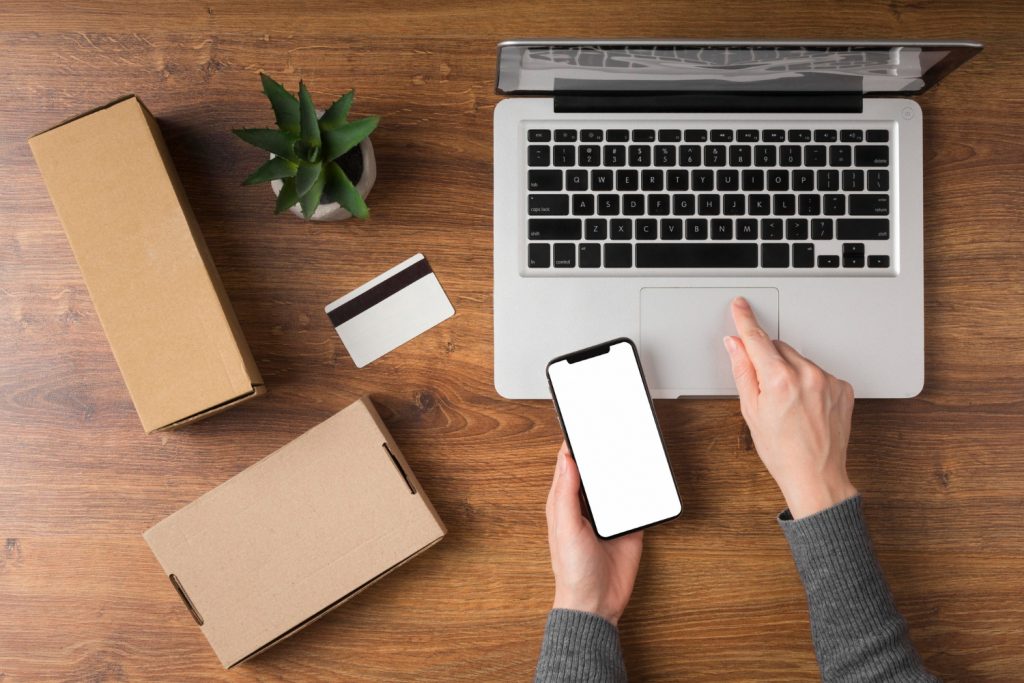E-commerce is one of the most promising digital spheres in the world. According to Insider intelligence, e-commerce sales for 2023 totaled $5.8 trillion and is projected to reach $6.3 trillion in 2024. With such colossal figures, many entrepreneurs want to start an ecommerce business, and ecommerce experts want to strengthen their position in this promising market.
But in such a competitive environment like e-commerce, you can successfully grow your business only by following e-commerce innovations. We tell you about the latest e-commerce innovations and latest ecommerce news.

E-commerce sales growth
The 2020 pandemic has changed the lives of a huge number of people, but it has also changed the course of many business areas. While street retail went bankrupt everywhere, e-commerce started to boom all over the world — people started to pay for all their purchases online. Even when the lockdown was lifted, people were still in the habit of ordering online, as it is much more convenient than going to stores and looking for the right product.
The future of e-commerce
The field of e-commerce sales trends is projected to grow every year — e-commerce sales trends are predicted to reach $8 trillion in 2027. Like any other digital niche, e-commerce will develop in parallel with IT and high technology — e-commerce innovations are constantly being made to simplify payment processes or introduce new ways to pay for goods and services.
However, this change is not always received positively — ecommerce entrepreneurs have to constantly monitor these changes and e-commerce trends to ensure their business remains relevant and profitable against the competition. With IT and high technology evolving very rapidly, it is quite possible that e-commerce will change beyond recognition in the near future of e-commerce.
To keep our readers abreast of developments in the e-commerce sphere, we have listed below the e-commerce trends. By the way, you can keep up with the latest ecommerce news at RateMeUp.
New trends in the e-commerce industry
Here are a few current e-commerce trends that are being actively adopted in the industry:
BNPL
BNPL (Buy Now, Pay Letter) is a technology used in e-commerce trends to split the payment of a purchase without charging interest. That is, the cost of goods is divided into two parts — the first part is paid immediately by the buyer, and the second part is deducted from his account after a certain period of time, for example, one month.
In this case, the seller receives payment in full immediately after payment of the first part of the bill — the main risks are assumed by the BNPL service, but the seller must pay a commission for the use of technology. If there is no money in the buyer’s account, the funds will be debited from the buyer’s account. If the buyer does not pay the second installment for a long time, he will not be able to use the technology in the future of e-commerce.
Typically, BNPL is used to paying for purchases costing $300 or less. You can learn about new technologies used in the digital industry in our RateMeUp section.
For the seller, the use of such technology helps to attract new customers and the average revenue per sale increases. It is also not uncommon for BNPL services to advertise the merchant on their website for free. Advantages for shoppers: purchases are paid without interest, there is no need to sign a contract with a bank, purchases have no impact on credit history, and there is no need to get a credit card.
Blockchain
Blockchain technologies have been actively introduced into daily lives for more than five years — some people are engaged in mining and trading cryptocurrencies, others use them in business or for storing savings in an alternative way. More recently, blockchain has become an ecommerce growth trends and is being actively used in this area.
The benefits of blockchain in e-commerce innovations include providing more secure payments for goods with privacy, with all financial transactions stored in the blockchain structure. The technology is also used as an alternative way to pay for purchases using cryptocurrency and an identifier of the authenticity of goods. The use of blockchain at Walmart Canada has reduced disputed invoices to 1%.
ChatGPT
ChatGPT has also found its place in e-commerce trends. This unique neural network is used in almost all digital niches because of its many advantages. Such as its ability to process complex queries and provide relevant answers based on them. In addition, using ChatGPT it is possible to create simpler bots to perform various tasks, for example, virtual assistants.
In e-commerce, ChatGPT can be applied in two areas — marketing and programming.
Marketing tasks that ChatGPT can handle:
- Finding new innovative ecommerce ideas for creatives;
- Generating images for creatives;
- Data collection;
- Preparing assignments for employees;
- Text rewriting;
- Selection of keywords for SEO optimization;
- Audience research on surveys.
Programming tasks ChatGPT can handle:
- Finding bugs in code;
- Writing code;
- Generating hints to solve problems.
ChatGPT does not always give quality responses to requests, so it is better to use the services of ecommerce experts to check the bot’s responses.
No-code and Low-code
No-code technology allows you to create seller platforms or programs without using program code — the creation is made of ready-made elements. This technology is actively used in e-commerce innovations to create seller platforms without the services of professional programmers.
Usually services that provide no-code technology have a low tariff plan, which starts from a few dollars for a monthly subscription. At the same time, the technology significantly reduces the amount of time it takes to create seller platforms or programs.
However, no-code has disadvantages, for example, management functions will belong to third parties and such constructors can not always give all the opportunities that can be achieved with a full-fledged code writing.
There is a similar technology — low-code. Low-code implies the creation of a site or program according to a ready-made template, but with the possibility of prescribing certain functions with the help of programming. For example, with low-code can be introduced to the seller platforms those functions that were not originally in the templates.

Voice search
Many people find it easier to use voice search than manual search, because it is convenient and can save time. Therefore, voice search feature is now often introduced on various online stores and other e-commerce related best seller platforms.
Voice search technology not only makes it easier to find the right products, but also opens up the possibility of finding the right products for people with disabilities, thus the site owner gets a new customer base. Usually the voice search function is applied by targeting users of mobile devices, as they are more likely to use such a function.
A prime example of a successful application of voice search is Amazon’s smart speaker, Alexa. Alexa can independently find the product that the user has named, pay for the purchase with a linked card and specify the delivery address.
Augmented reality
Previously, the main problem of buying clothes online was the lack of opportunity to try on clothes before purchase. However, this problem has been solved by the advent of augmented reality technology in e-commerce. Moreover, the technology is not only used in the clothing segment — with the help of AR, you can find out how costume and jewelry will look before buying, as well as try out cosmetics using only your phone.
PWA
PWA (progressive web applications) is a technology for creating applications based on programming languages that are used to create best seller platforms. Such programs combine the features of both mobile applications and websites, for example, you can go to PWA by following a link or downloading the application to your device.
The pros of PWAs are that it is very convenient for customers, such applications do not take up a lot of memory on the device, they have a simplified interface, and also they are instantly updated. For businesses, it is much more economical to use PWAs, as you don’t need to write separate code to create them — you just need to adapt the website code. In addition, PWAs can be used on any operating system. Starbucks started using PWA technology and doubled the number of active users.
Personalization
If a user has bought a particular product, there is a high probability that they will buy a similar product next time. Therefore, it will be beneficial for e-commerce entrepreneurs to «prompt» customers which product they want to buy.
This requires the use of personalized product picks that focus on the preferences of specific users. Personalized selections are based on a user’s previous purchases, their search queries and the categories they visit. Such selections speed up product selection, which saves time for both the merchant and the customer, and increases revenue. CMS-systems can be used to create personalized selections, as well as Insider, REES46 or Retail Rocket services.
Lifestream shopping
Lifestream shopping appeared in 2016 on the Chinese marketplace Taobao and is actively gaining popularity in e-commerce. The essence of the ecommerce growth trends is that the blogger or the seller himself demonstrates and sells goods on a live broadcast.
Lifestream shopping combines shopping and entertainment, so it becomes more popular every year — ecommerce experts predict that the income from Lifestream shopping will be from 10% to 20% of all e-commerce sales.
And with the help of Lifestream shopping it is possible to sell not only small household goods and cosmetics — there are known cases of selling real estate, cars and even commercial packages of access to the launch of space rockets. New interesting e-commerce cases and other digital spheres can be found on RateMeUp.

FAQ
What was the impetus for the beginning of the development of the e-commerce sector?
The sphere of e-commerce began to develop actively in 2020, when the coronavirus pandemic caused a lockdown in almost all countries of the world. Because of this, people started ordering goods online much more frequently.
What is BNPL?
BNPL is a technology which people can use to pay for goods in installments.
How can ChatGPT be applied in e-commerce?
ChatGPT can be applied in innovative ecommerce ideas to solve programming and marketing problems. For example, ChatGPT can write program code or write a description for a product.
In what year did the Lifestream shopping ecommerce growth trends appear?
Live broadcasts with the sale of various goods appeared on the Chinese marketplace Taobao ecommerce news in 2016 and immediately began to become popular, as on such live broadcasts sellers or bloggers not only offered to buy goods, but also entertained viewers. In the future of e-commerce, lifestream shopping is expected to bring the major share of sales trends in this industry.

